Growing Bonsai Trees
Japanese Garden Design
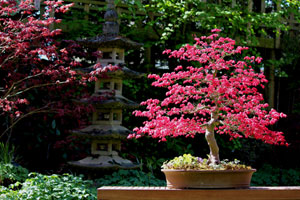
Perhaps the ultimate accessory for any Japanese garden or koi pond is a miniature bonsai tree, or even better, a collection of different bonsai, displayed on a tiered wooden bench or on individual plinths.
Sizes and Styles
These tiny, artificially dwarfed trees come in all sizes, ranging from those that will fit in the palm of your hand (mame) and slightly larger versions (shohin), to specimens that are as much as three or four feet high, requiring two strong people to carry them due to their considerable weight and bulk.
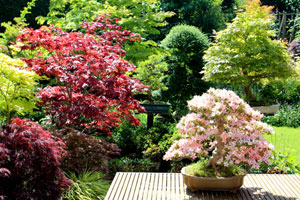
Formal upright style (chokkan) Japanese white and black pines are particularly iconic species when treated in this way, with their alternating branches of foliage pads appearing a little contrived. Pines are also grown in less topiary-like styles, such as the elegant literati (bunjingi), where these trees resemble the ink drawings of graceful pines on ancient Japanese and Chinese scroll pictures.
Many other bonsai species are equally impressive in their appearance, such as a zelkova growing in the twiggy broom style (hokidachi) and a Japanese maple growing in an informal upright style (moyogi), with a curvy trunk and branches emerging on the outsides of the curves. Multiple trunks (such as twin trunks or 'sokan') and group plantings (yose-ue) can be quite enchanting, with the latter appearing like tiny forests, where with a little bit of imagination you can see yourself walking along the pathways between the tree trunks.
Pruning Techniques
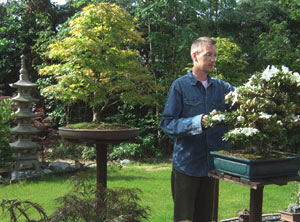
Growing bonsai trees is a combination of horticultural knowledge and artistic styling. When the plant becomes pot-bound, root pruning is necessary, where the tree is removed from its shallow pot, the roots raked out with a fork tool, and then trimmed back by up to a third with a sharp pair of scissors. This technique should be carried out in the early spring, just as the tree is awakening from its winter dormancy. Small, young bonsai trees will most likely need to be root pruned every year or two, while older, slower-growing specimens may not need to be repotted for five or six years.
People often mistakenly think that root pruning is what dwarfs a bonsai tree and that this method of pruning is 'cruel'. However, it just simply makes the root system more dense and efficient, promoting the growth of fine feeder roots. It is a horticultural technique employed by many gardeners over the years, both for container-grown plants and to promote more flowers when planting out herbaceous plants.
Root pruning a bonsai tree somewhat invigorates it, promoting stronger and healthier growth. It is actually the skillful directional pruning that is what keeps the plant small and attractive, while wrapping bendable copper or aluminium wire around the branches allows the perfect shape to be achieved.
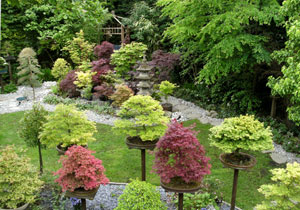
Indoor or Outdoors?
Another common misconception is the bonsai trees are grown inside the house, on a windowsill. Whilst tropical tree species can be grown inside in this way, such as bougainvillea, figs, pistachio, podocarpus, sageretia and serissa, plants that would naturally grow in a cooler environment may only be brought inside to be appreciated for a day or two.
Popular outdoor deciduous and evergreen species include azalea (rhododendron), beech, cryptomeria, cypress, elm, ginkgo, hornbeam, Japanese maple, oak, pine, spruce, willow, wisteria, yew and zelkova, amongst many others.
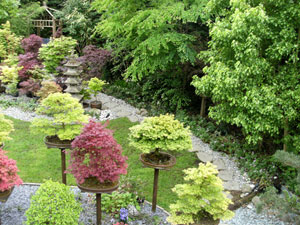
Sources
Where you initially obtain your bonsai tree from depends on a number of factors, such as your budget and your patience. Growing a tree from a seed or cutting may take years for it to become anywhere near a specimen, while starting off with a shrubby stock plant from a garden centre will require some styling knowledge and experience, and several years of training.
Alternatively, a trip to a bonsai nursery may be in order, while naturally dwarfed trees growing in the wild may be collected from cliffs and quarries, with permission of course. An old hedgerow is another good source, where the trees are especially twiggy after years of pruning.
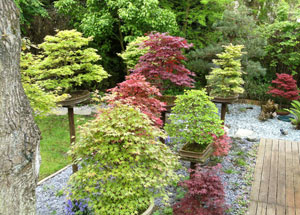
Longevity and Lifespan
Whatever you decide, it is important to note that your bonsai trees will require a great deal of attention over the years, such as daily watering during the summer months, periodic feeding and regular pruning / styling sessions. However, your efforts will be rewarded with some beautiful miniature trees in perfection that resemble their counterparts in the wild.
Looked after well, your collection may well end up being passed down to generations, with some of the oldest Japanese bonsai being several hundred years old.
 Perhaps the ultimate accessory for any Japanese garden or koi pond is a miniature bonsai tree, or even better, a collection of different bonsai, displayed on a tiered wooden bench or on individual plinths.
Perhaps the ultimate accessory for any Japanese garden or koi pond is a miniature bonsai tree, or even better, a collection of different bonsai, displayed on a tiered wooden bench or on individual plinths. Formal upright style (chokkan) Japanese white and black pines are particularly iconic species when treated in this way, with their alternating branches of foliage pads appearing a little contrived. Pines are also grown in less topiary-like styles, such as the elegant literati (bunjingi), where these trees resemble the ink drawings of graceful pines on ancient Japanese and Chinese scroll pictures.
Formal upright style (chokkan) Japanese white and black pines are particularly iconic species when treated in this way, with their alternating branches of foliage pads appearing a little contrived. Pines are also grown in less topiary-like styles, such as the elegant literati (bunjingi), where these trees resemble the ink drawings of graceful pines on ancient Japanese and Chinese scroll pictures. Growing bonsai trees is a combination of horticultural knowledge and artistic styling. When the plant becomes pot-bound, root pruning is necessary, where the tree is removed from its shallow pot, the roots raked out with a fork tool, and then trimmed back by up to a third with a sharp pair of scissors. This technique should be carried out in the early spring, just as the tree is awakening from its winter dormancy. Small, young bonsai trees will most likely need to be root pruned every year or two, while older, slower-growing specimens may not need to be repotted for five or six years.
Growing bonsai trees is a combination of horticultural knowledge and artistic styling. When the plant becomes pot-bound, root pruning is necessary, where the tree is removed from its shallow pot, the roots raked out with a fork tool, and then trimmed back by up to a third with a sharp pair of scissors. This technique should be carried out in the early spring, just as the tree is awakening from its winter dormancy. Small, young bonsai trees will most likely need to be root pruned every year or two, while older, slower-growing specimens may not need to be repotted for five or six years.

